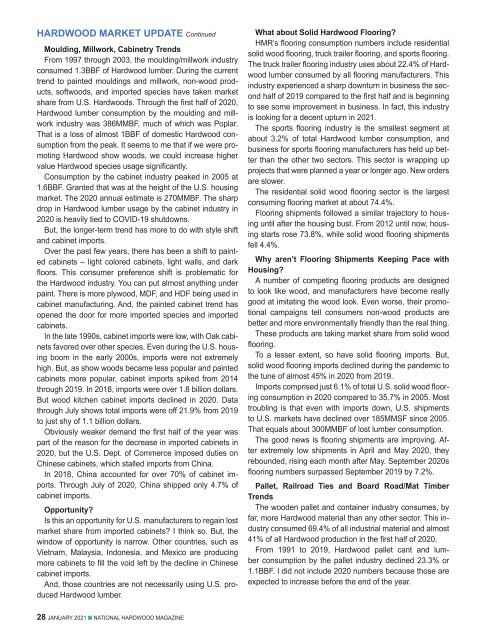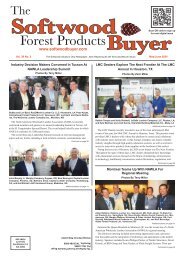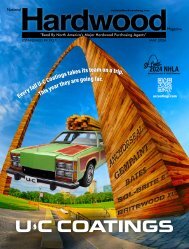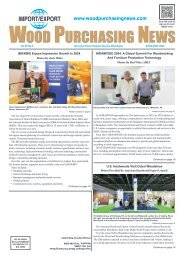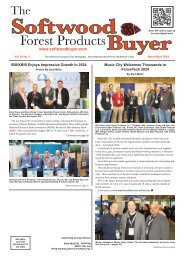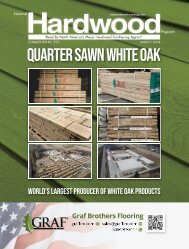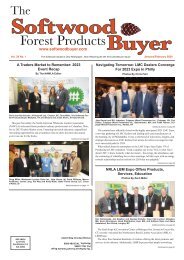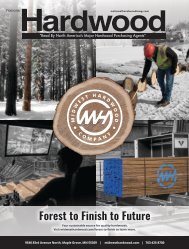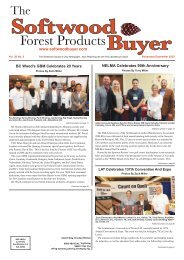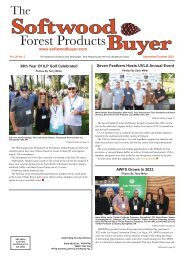National Hardwood Magazine - January 2021
In this issue of National Hardwood Magazine, get to know the team at Hardwood Floors of Hillsboro, see predictions for the 2021 Wood Products Industry, and check out the graduating class of the NHLA Inspector Training School.
In this issue of National Hardwood Magazine, get to know the team at Hardwood Floors of Hillsboro, see predictions for the 2021 Wood Products Industry, and check out the graduating class of the NHLA Inspector Training School.
Create successful ePaper yourself
Turn your PDF publications into a flip-book with our unique Google optimized e-Paper software.
HARDWOOD MARKET UPDATE Continued<br />
Moulding, Millwork, Cabinetry Trends<br />
From 1997 through 2003, the moulding/millwork industry<br />
consumed 1.3BBF of <strong>Hardwood</strong> lumber. During the current<br />
trend to painted mouldings and millwork, non-wood products,<br />
softwoods, and imported species have taken market<br />
share from U.S. <strong>Hardwood</strong>s. Through the first half of 2020,<br />
<strong>Hardwood</strong> lumber consumption by the moulding and millwork<br />
industry was 386MMBF, much of which was Poplar.<br />
That is a loss of almost 1BBF of domestic <strong>Hardwood</strong> consumption<br />
from the peak. It seems to me that if we were promoting<br />
<strong>Hardwood</strong> show woods, we could increase higher<br />
value <strong>Hardwood</strong> species usage significantly.<br />
Consumption by the cabinet industry peaked in 2005 at<br />
1.6BBF. Granted that was at the height of the U.S. housing<br />
market. The 2020 annual estimate is 270MMBF. The sharp<br />
drop in <strong>Hardwood</strong> lumber usage by the cabinet industry in<br />
2020 is heavily tied to COVID-19 shutdowns.<br />
But, the longer-term trend has more to do with style shift<br />
and cabinet imports.<br />
Over the past few years, there has been a shift to painted<br />
cabinets – light colored cabinets, light walls, and dark<br />
floors. This consumer preference shift is problematic for<br />
the <strong>Hardwood</strong> industry. You can put almost anything under<br />
paint. There is more plywood, MDF, and HDF being used in<br />
cabinet manufacturing. And, the painted cabinet trend has<br />
opened the door for more imported species and imported<br />
cabinets.<br />
In the late 1990s, cabinet imports were low, with Oak cabinets<br />
favored over other species. Even during the U.S. housing<br />
boom in the early 2000s, imports were not extremely<br />
high. But, as show woods became less popular and painted<br />
cabinets more popular, cabinet imports spiked from 2014<br />
through 2019. In 2018, imports were over 1.8 billion dollars.<br />
But wood kitchen cabinet imports declined in 2020. Data<br />
through July shows total imports were off 21.9% from 2019<br />
to just shy of 1.1 billion dollars.<br />
Obviously weaker demand the first half of the year was<br />
part of the reason for the decrease in imported cabinets in<br />
2020, but the U.S. Dept. of Commerce imposed duties on<br />
Chinese cabinets, which stalled imports from China.<br />
In 2018, China accounted for over 70% of cabinet imports.<br />
Through July of 2020, China shipped only 4.7% of<br />
cabinet imports.<br />
Opportunity?<br />
Is this an opportunity for U.S. manufacturers to regain lost<br />
market share from imported cabinets? I think so. But, the<br />
window of opportunity is narrow. Other countries, such as<br />
Vietnam, Malaysia, Indonesia, and Mexico are producing<br />
more cabinets to fill the void left by the decline in Chinese<br />
cabinet imports.<br />
And, those countries are not necessarily using U.S. produced<br />
<strong>Hardwood</strong> lumber.<br />
What about Solid <strong>Hardwood</strong> Flooring?<br />
HMR’s flooring consumption numbers include residential<br />
solid wood flooring, truck trailer flooring, and sports flooring.<br />
The truck trailer flooring industry uses about 22.4% of <strong>Hardwood</strong><br />
lumber consumed by all flooring manufacturers. This<br />
industry experienced a sharp downturn in business the second<br />
half of 2019 compared to the first half and is beginning<br />
to see some improvement in business. In fact, this industry<br />
is looking for a decent upturn in <strong>2021</strong>.<br />
The sports flooring industry is the smallest segment at<br />
about 3.2% of total <strong>Hardwood</strong> lumber consumption, and<br />
business for sports flooring manufacturers has held up better<br />
than the other two sectors. This sector is wrapping up<br />
projects that were planned a year or longer ago. New orders<br />
are slower.<br />
The residential solid wood flooring sector is the largest<br />
consuming flooring market at about 74.4%.<br />
Flooring shipments followed a similar trajectory to housing<br />
until after the housing bust. From 2012 until now, housing<br />
starts rose 73.8%, while solid wood flooring shipments<br />
fell 4.4%.<br />
Why aren’t Flooring Shipments Keeping Pace with<br />
Housing?<br />
A number of competing flooring products are designed<br />
to look like wood, and manufacturers have become really<br />
good at imitating the wood look. Even worse, their promotional<br />
campaigns tell consumers non-wood products are<br />
better and more environmentally friendly than the real thing.<br />
These products are taking market share from solid wood<br />
flooring.<br />
To a lesser extent, so have solid flooring imports. But,<br />
solid wood flooring imports declined during the pandemic to<br />
the tune of almost 45% in 2020 from 2019.<br />
Imports comprised just 6.1% of total U.S. solid wood flooring<br />
consumption in 2020 compared to 35.7% in 2005. Most<br />
troubling is that even with imports down, U.S. shipments<br />
to U.S. markets have declined over 185MMSF since 2005.<br />
That equals about 300MMBF of lost lumber consumption.<br />
The good news is flooring shipments are improving. After<br />
extremely low shipments in April and May 2020, they<br />
rebounded, rising each month after May. September 2020s<br />
flooring numbers surpassed September 2019 by 7.2%.<br />
Pallet, Railroad Ties and Board Road/Mat Timber<br />
Trends<br />
The wooden pallet and container industry consumes, by<br />
far, more <strong>Hardwood</strong> material than any other sector. This industry<br />
consumed 69.4% of all industrial material and almost<br />
41% of all <strong>Hardwood</strong> production in the first half of 2020.<br />
From 1991 to 2019, <strong>Hardwood</strong> pallet cant and lumber<br />
consumption by the pallet industry declined 23.3% or<br />
1.1BBF. I did not include 2020 numbers because those are<br />
expected to increase before the end of the year.<br />
The <strong>Hardwood</strong> consumption numbers are not going down<br />
because fewer pallets are being made.<br />
So why has <strong>Hardwood</strong> consumption declined over time?<br />
Pine and other softwoods have taken market share as well<br />
as plastic and other non-wood materials.<br />
Estimates show the global market for pallets should increase<br />
to $88.69 billion by 2026, with a compounded annual<br />
growth rate of 5.1%.<br />
Wood pallets are expected to account for the largest<br />
share of the global market, but plastic pallets are expected<br />
to grow the fastest.<br />
The railway tie industry is the only <strong>Hardwood</strong> consuming<br />
market that has grown since 1991. <strong>Hardwood</strong> usage has increased<br />
over 31% since 1991. From 2012 through 2017 the<br />
railroad industry consumed over 1BBF of <strong>Hardwood</strong> material<br />
per year. There is a very easy explanation as to why we<br />
have seen this level of growth. The Railway Tie Association<br />
began the 2 cent per tie program in the early 1980s that<br />
provides funding for research and development, as well as<br />
promotional campaigns for wood railroad ties. These efforts<br />
have proven wood is the best option for ties.<br />
Longer term, rail shipments are expected to increase<br />
even more. The U.S. Department of Transportation projects<br />
1999 <strong>Hardwood</strong><br />
Consumption<br />
Grade<br />
Lumber<br />
Pallet<br />
Lumber,<br />
Cants,<br />
and Ties<br />
59.6% 40.4%<br />
Industrial Products: 5.21B bd. ft.<br />
Grade Lumber: 7.7B bd. ft.<br />
rail traffic to rise 24% over the next 30 years. With higher rail<br />
traffic comes more tie installations.<br />
Even with green 4/4 No. 2A Red Oak prices increasing,<br />
there is certainly incentive for sawmill operators to saw railroad<br />
ties. Not even taking into account the yield and production<br />
advantages of cutting ties, prices for ties are substantially<br />
higher than for green 4/4 No. 2A Red Oak.<br />
Railway Tie Association Data shows a 4.9% decrease in<br />
purchases this year from 2019. But purchases are expected<br />
to regain some of those losses in <strong>2021</strong>, up 2.8% to over 18<br />
million ties.<br />
What about the Board Road/Crane Mat industry?<br />
These are some of the demand drivers for board road<br />
and mat timbers.<br />
• Transmission Lines<br />
• Pipelines<br />
• Drilling<br />
• Roads and Bridges<br />
• General Construction<br />
• Board road and mat timber consumption is down. Estimates<br />
for the first half of 2020 show usage is off 18.0% from<br />
2019 to an annual rate of 346MMBF. With high inventories<br />
and weak demand, it is likely this industry will not see much<br />
improvement in <strong>2021</strong>. •••<br />
41.1%<br />
2020 <strong>Hardwood</strong><br />
Consumption<br />
Grade<br />
Lumber<br />
Pallet<br />
Lumber,<br />
Cants,<br />
Ties,<br />
Board<br />
Please turn to page 38<br />
58.9%<br />
Industrial Products: 3.709BBF<br />
Grade Lumber: 2.588BBF<br />
Total: 6.297BBF<br />
28 JANUARY <strong>2021</strong> n NATIONAL HARDWOOD MAGAZINE JANUARY <strong>2021</strong> n NATIONAL HARDWOOD MAGAZINE 29


